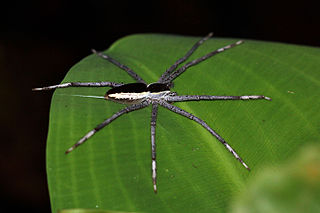
Nursery web spiders (Pisauridae) is a family of araneomorph spiders first described by Eugène Simon in 1890. They resemble wolf spiders (Lycosidae) except for several key differences. Wolf spiders have two very prominent eyes in addition to the other six, while a nursery web spider's eyes are all about the same size. Additionally, female nursery web spiders carry their egg sacs with their jaws and pedipalps instead of attaching them to their spinnerets as wolf spiders do. When the eggs are about to hatch, a female spider builds a nursery "tent", places her egg sac inside, and stands guard outside, hence the family's common name. Like the wolf spiders, however, the nursery web spiders are roaming hunters that don't use webs for catching prey.

Ctenizidae is a small family of medium-sized mygalomorph spiders that construct burrows with a cork-like trapdoor made of soil, vegetation and silk. They may be called trapdoor spiders, as are similar species, such as those of the families Liphistiidae, Barychelidae, Cyrtaucheniidae and some species in Idiopidae and Nemesiidae. In 2018, the family Halonoproctidae was split off from Ctenizidae, leaving only three genera.

The wafer trapdoor spiders, family Cyrtaucheniidae, are a widespread family of spiders that lack the thorn-like spines on tarsi and metatarsi I and II found in true trapdoor spiders (Ctenizidae).
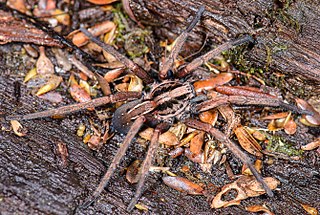
Miturgidae is a family of araneomorph spiders that includes nearly 170 species in 29 genera worldwide. First described by Eugène Simon in 1886, it has been substantially revised, including of previous family "Zoridae" as subfamily "Zorinae" and excluding the family "Xenoctenidae". Several genera have also been removed, such as the large genus Cheiracanthium, which was transferred to the Eutichuridae.

Orb-weaver spiders or araneids are members of the spider family Araneidae. They are the most common group of builders of spiral wheel-shaped webs often found in gardens, fields and forests. "Orb" can in English mean "circular", hence the English name of the group. Araneids have eight similar eyes, hairy or spiny legs, and no stridulating organs.
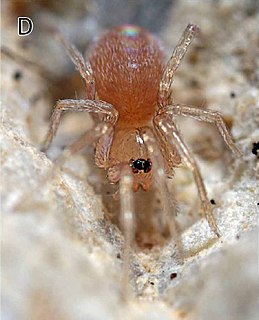
Oonopidae, also known as is a goblin spiders, is a family of spiders consisting of over 1,600 described species in about 113 genera worldwide, with total species diversity estimated at 2000 to 2500 species. The type genus of the family is OonopsKeyserling, 1835.

Velvet spiders (Eresidae) are a small group of spiders almost entirely limited to the Old World, with exception of a few species known from Brazil. The characteristics of this family of spiders are that they are entelegyne, eight-eyed araneomorph spiders that build unkempt webs. They are cribellate. Some species are nearly eusocial, lacking only a specialized caste system and a queen. They cooperate in brood rearing, unlike most other spiders except for some African agelenid spiders in the genus Agelena and a few others.

Idiopidae, also known as armored trapdoor spiders, is a family of mygalomorph spiders first described by Eugène Simon in 1889. They have a large body similar to tarantulas.
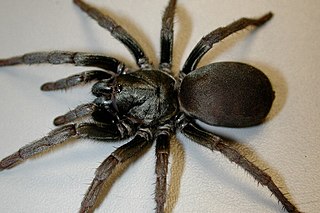
Nemesiidae, also known as funnel-web tarantulas, is a family of mygalomorph spiders first described by Eugène Simon in 1889, and raised to family status in 1985. Before becoming its own family, it was considered part of "Dipluridae". Fossils have been found dating this family back to the Lower Cretaceous.

Barychelidae, also known as brushed trapdoor spiders, is a spider family with about 300 species in 42 genera. Most spiders in this family build trapdoor burrows. For example, the 20 millimetres (0.79 in) long Sipalolasma builds its burrow in rotted wood, with a hinged trapdoor at each end. The 10 millimetres (0.39 in) long Idioctis builds its burrow approximately 5 centimetres (2.0 in) deep, just below the high tide level, sealing the opening with a thin trapdoor.
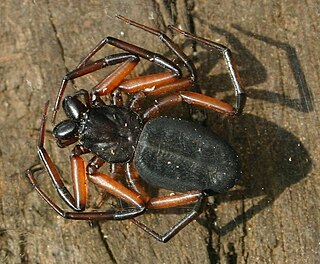
Trochanteriidae is a family of spiders first described by Ferdinand Karsch in 1879 containing about 180 species in 21 genera. Most are endemic to Australia though Doliomalus and Trochanteria are from South America and Olin and Plator are from Asia. Platyoides species exist in southern and eastern Africa, Madagascar, and the Canary Islands with one species, P. walteri, introduced to Australia.

Orsolobidae is a six-eyed spider family with about 180 described species in thirty genera. It was first described by J. A. L. Cooke in 1965, and was raised to family status from "Dysderidae" in 1985.
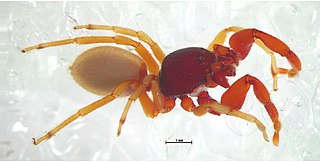
Palpimanidae, also known as palp-footed spiders, is a family of araneomorph spiders first described by Tamerlan Thorell in 1890. They are widely distributed throughout the tropical and subtropical regions of the world, the Mediterranean and one in Uzbekistan, but not Australia. They are not common and there is a high degree of endemism.
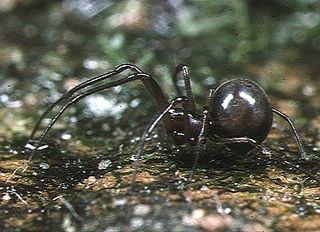
Anapidae is a family of rather small spiders with 231 described species in 58 genera. It includes the former family Micropholcommatidae as the subfamily Micropholcommatinae. Most species are less than 2 millimetres (0.079 in) long.

Cyatholipidae is a family of spiders first described by Eugène Simon in 1894. Most live in moist, montane forests, though several species, including Scharffia rossi, live in dry savannah regions. They occur in Africa, including Madagascar, New Zealand and Australia, and one species in Jamaica. Most members of this family hang beneath sheet webs. Fossil species occur in the Eocene aged Bitterfield and Baltic Ambers, suggesting a wider geographic distribution in the past.

Mysmenidae is a spider family with about 135 described species in thirteen genera. The family is one of the least well known of the orb-weaving spiders because of their small size and cryptic behaviour. These spiders are found in humid habitats such as among leaf litter and in caves.

Moggridgea is a genus of spiders in the tree dwelling family, Migidae. The genus was first described by Octavius Pickard-Cambridge in 1875, who named the genus after naturalist John Traherne Moggridge.

Paramigas is a genus of tree trapdoor spiders native to Madagascar. It was first described by Reginald Innes Pocock in 1895.

Toxopidae is a small family of araneomorph spiders, first described in 1940. For many years it was sunk into Desidae as a subfamily, although doubts were expressed as to whether this was correct. A large-scale molecular phylogenetic study in 2016 led to the family being revived.




















